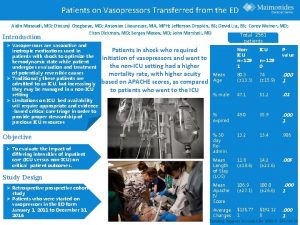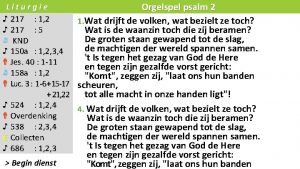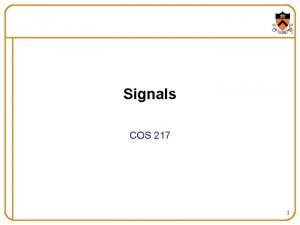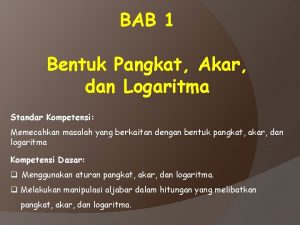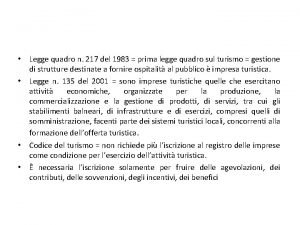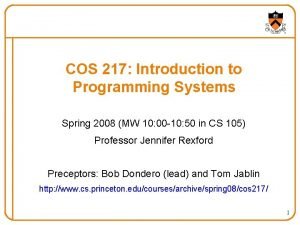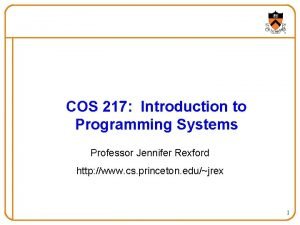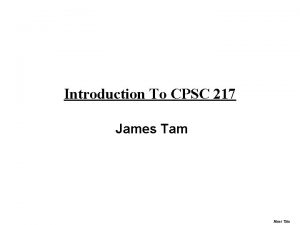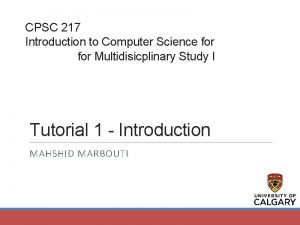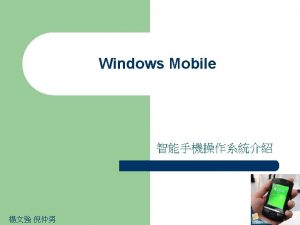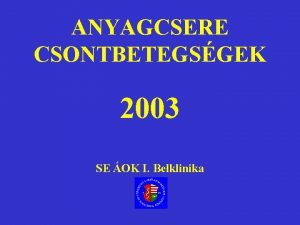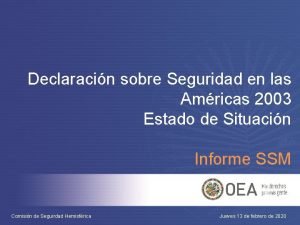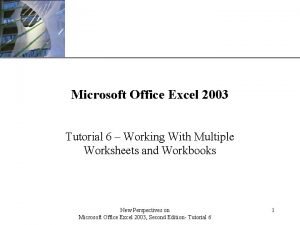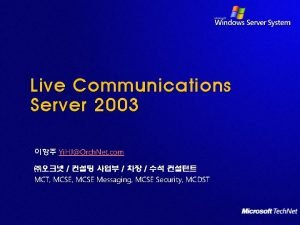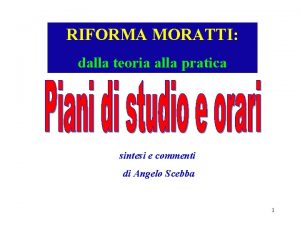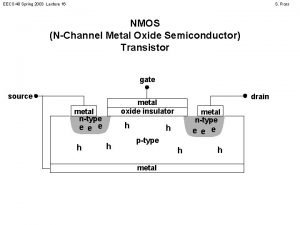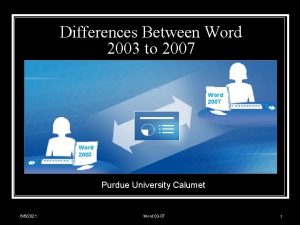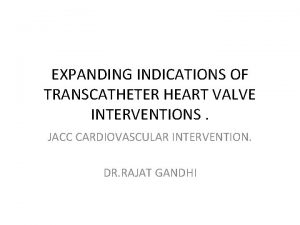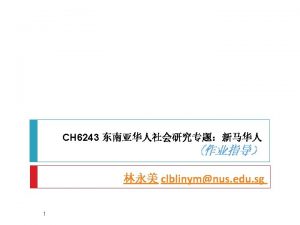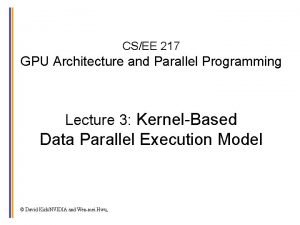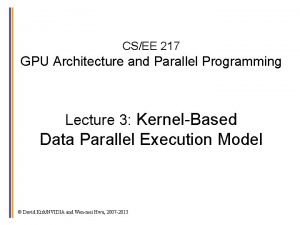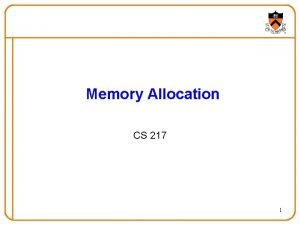1 Masoudi et al JACC 2003 41 217









































- Slides: 41



Встречаемость сердечной диссинхронии при ХСН 1. Masoudi, et al. JACC 2003; 41: 217 -23 2. Aaronson, et al. Circ 1997; 95: 2660 -7


Прогноз при желудочковой диссинхронии Baldasseroni S, et al. Eur Heart J 2002; 23: 1692 -98 N=5, 517


CRT: Процедура имплантации и Риски Period Attempts Primary LV Lead MIRACLE 11/98 – 12/00 591 Attain 2187 Contak CD 2/98 – 12/00 517 Easy. Trak MIRACLE ICD 10/99 – 8/01 636 Attain 4189 In. Sync III 11/00 – 6/02 334 Attain 4193 Study 1. Greenberg, et al. PACE 2003; 26(4 p 2): 952 (Abstract 93) 2. Unpublished data. Medtronic. Inc.

CRT не усугубляет желудочковые аритмии • 1044 пациентов с ИКД в 2 трайлах: – CONTAK CD – MIRACLE ICD • Odds ratio (CI): 0. 92 (0. 67 – 1. 27) Bradley DJ, et al. JAMA 2003; 289: 730 -740 Doug Smith:



CRT улучшает качество жизни и ФК Qo. L Score (MLWHF) Avg. Change Improve. NYHA Class Proportion Changing 1 or more Classes Not Reported Data sources: MIRACLE: Circulation 2003; 107: 1985 -90 MUSTIC SR: NEJM 2001; 344: 873 -80 MIRACLE ICD: JAMA 2003; 289: 2685 -94 Contak CD: J Am Coll Cardiol 2003; 42: 1454 -59 Control CRT

CRT улучшает переносимость физических нагрузок 6 Min Walk Avg. Change (m) Peak VO 2 Avg. Change (m. L/kg/min) Data sources: MIRACLE: Circulation 2003; 107: 1985 -90 MUSTIC SR: NEJM 2001; 344: 873 -80 MIRACLE ICD: JAMA 2003; 289: 2685 -94 Contak CD: J Am Coll Cardiol 2003; 42: 1454 -59 Control CRT

Эффект CRT на анатомию ЛЖ у пациентов с ХСН Изменение КДО, мл Not Reported Изменение КДР, мл Data sources: MIRACLE: Circulation 2003; 107: 1985 -1990 MIRACLE ICD: JAMA 2003; 289: 2685 -2694 Contak CD: J Am Coll Cardiol 2003; 42: 1454 -1459 Control CRT


CRT улучшает сердечную функцию через 6 мес Улучшение ФВ, % Площадь митр регургитации, cm 2 Data sources: MIRACLE: Circulation 2003; 107: 1985 -1990 MIRACLE ICD: JAMA 2003; 289: 2685 -2694 Contak CD: J Am Coll Cardiol 2003; 42: 1454 -1459 Not Reported Control CRT

























In. Sync® System Disclosure (In. Sync® 8040 Generator/In. Sync® III 8042 Generator/In. Sync ICD® 7272/In. Sync® Marquis™ 7227/In. Sync® II Marquis™ 7289/Attain™ Models 2187, 4193, and 2188 Leads/9790/2090 Programmer) Indications • The In. Sync® Model 8040, In. Sync® III Model 8042, In. Sync ICD® Model 7272, In. Sync® Marquis™ Model 7277 and In. Sync® II Marquis™ Model 7289 devices are indicated for the reduction of the symptoms of moderate to severe heart failure (NYHA Functional Class III or IV) in those patients who remain symptomatic despite stable, optimal medical therapy, and have a left ventricular ejection fraction 35% and a QRS duration 130 ms. • The In. Sync ICD Model 7272, In. Sync Marquis Model 7277 and In. Sync II Marquis Model 7289 are also intended to provide ventricular antitachycardia pacing and ventricular defibrillation for automated treatment of life-threatening ventricular arrhythmias. • The In. Sync III Model 8042 is also intended to provide rate adaptive pacing for patients who may benefit from increased pacing rates concurrent with increases in activity. Rate adaptive pacing is intended only for those patients developing a bradycardia indication who might benefit from increased pacing rates concurrent with increases in activity. Dual chamber and atrial tracking modes are indicated for patients who may benefit from maintenance of AV synchrony. • The Medtronic Model 9790 and 2090 programmers are portable, microprocessor-based instrument used to program Medtronic implantable devices. • The Attain LV Model 2187 and Attain OTW Model 4193 leads have application as part of a Medtronic biventricular pacing system. • The Attain CS Model 2188 lead has application where permanent atrial or dual chamber pacing systems are indicated, or as part of a Medtronic biventricular pacing system. Contraindications • The In. Sync ICD, In. Sync Marquis and In. Sync II Marquis are contraindicated for patients whose ventricular tachyarrhythmias may have transient or reversible causes. • The In. Sync ICD, In. Sync Marquis and In. Sync II Marquis are contraindicated for patients with incessant VT or VF. • The In. Sync and In. Sync III are contraindicated for dual chamber atrial pacing in patients with chronic refractory atrial tachyarrhythmias. • Asynchronous pacing is contraindicated in the presence (or likelihood) of competitive or intrinsic rhythms. • Unipolar pacing is contraindicated in patients with an implanted defibrillator or cardioverter defibrillator (ICD) because it may cause unwanted delivery or inhibition of defibrillator or ICD therapy. • The Attain Models 2187, 2188, and 4193 leads are contraindicated for patients with coronary venous vasculature that is inadequate for lead placement, as indicated by venogram. • For the Model 4193 lead, do not use steroid-eluting leads in patients for whom a single dose of 1. 0 mg dexamethasone sodium phosphate may traindicated. be con

In. Sync® System Disclosure, continued. Warnings and Precautions • Patients implanted with these systems should avoid sources of magnetic resonance imaging, diathermy, high sources of radiation, electrosurgical cautery, external defibrillation, lithotripsy, and radiofrequency ablation. These may result in under detection of VT/VF, inappropriate therapy delivery, and/or electrical reset of the device. • Certain programming and device operations may not provide cardiac resynchronization. • The In. Sync and In. Sync III Elective Replacement Indicators (ERI) result in the device switching to VVI pacing at 65 ppm. In this mode, patients will experience loss of cardiac resynchronization therapy and/or loss of AV synchrony. For this reason, the device should be replaced prior to ERI being set. • An implantable defibrillator may be implanted concomitantly with an In. Sync or In. Sync III system, provided implant protocols are followed for device and defibrillator lead placement and device configuration. • Leads and stylets should be handled with great care at all times. When using a Model 4193 lead, only use compatible stylets (stylets with downsized knobs and are 3 cm shorter than the lead length). • Use care when handling guide wires. Damage to the guide wire may prevent the guide wire from performing accurate torque response control and may cause vessel damage. Do not use excessive force to remove a guide wire from a lead. Refer to the literature packaged with the guide wire for additional information on guide wires. • Chronic repositioning or removal of leads may be difficult because of fibrotic tissue development. The clinical study was not designed to evaluate the removal of left ventricular leads from the coronary venous vasculature. • Output pulses, especially from unipolar leads, may adversely affect device sensing capabilities. • Previously implanted pulse generators, implantable cardioverter defibrillators, and leads should generally be explanted. • Backup pacing should be readily available during implant. Use of leads may cause heart block. • Do not force the guide catheter and/or leads if significant resistance is encountered. Use of the leads may cause trauma to the heart. • For the Model 4193 lead, it has not been determined if whether the warnings, precautions, or complications usually associated with injectable dexamethasone sodium phosphate apply to the use of this highly localized, controlled-release device. For a list of potential adverse effects, refer to the Physician’s Desk Reference. See the appropriate technical manuals for detailed information regarding instructions for use, indications, contraindications, warnings and precautions, and potential adverse events. Caution: Federal law (USA) restricts these devices to sale by or on the order of a physician.
 Aidin masoudi
Aidin masoudi Jacc submission
Jacc submission Psalm 217
Psalm 217 Bio 217
Bio 217 Cos 217
Cos 217 49 cfr part 217
49 cfr part 217 Cos 217
Cos 217 Persamaan 7 log 217 + 7 log 31 ialah
Persamaan 7 log 217 + 7 log 31 ialah Cos 217
Cos 217 Kuo y yasu
Kuo y yasu El pluscuamperfecto p 217
El pluscuamperfecto p 217 Legge quadro 1983
Legge quadro 1983 30 tac 217
30 tac 217 Cos217
Cos217 Cos217
Cos217 James tam u of c
James tam u of c De vulgari eloquentia mappa concettuale
De vulgari eloquentia mappa concettuale Cpsc 217
Cpsc 217 Http://sciencespot.net
Http://sciencespot.net Metric mania mass answer key
Metric mania mass answer key Windows mobile 2003
Windows mobile 2003 Wpc 2003
Wpc 2003 2023-2003
2023-2003 Excel cursus 2003
Excel cursus 2003 Http://sciencespot.net
Http://sciencespot.net 2003 se
2003 se Declaración sobre seguridad en las américas 2003
Declaración sobre seguridad en las américas 2003 Excel 2003 tutorial
Excel 2003 tutorial Live communications server 2003
Live communications server 2003 La ley 850
La ley 850 Forest conservation rules 2003
Forest conservation rules 2003 Rod ellis 2003
Rod ellis 2003 Eesti laulja 1947-2003
Eesti laulja 1947-2003 2003-1972
2003-1972 53/2003 sintesi
53/2003 sintesi 2003 august 25
2003 august 25 2003
2003 T.trimpe 2003 http //sciencespot.net/ answers
T.trimpe 2003 http //sciencespot.net/ answers Creswell 2003
Creswell 2003 2003 april 20
2003 april 20 Word 2003 to 2007
Word 2003 to 2007 2003 ub
2003 ub
